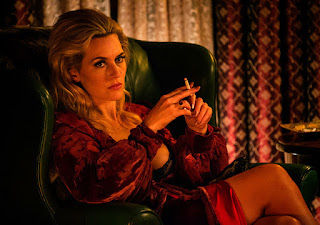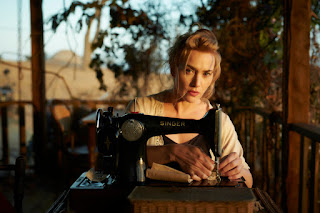Cliccate qui: http://www.vanityfair.it/show/cinema/16/03/23/the-dressmaker-kate-winslet-film-trailer-foto
e seguiteci su Facebook! https://www.facebook.com/simplykatewinslet/
Sensuale, diabolica, adorabile. Avvolta in un abito rosso fiammante (che fa pendant con il fuoco infernale alle sue spalle), spacco vertiginoso e sguardo fiero, Kate Winslet campeggia così, superba e sexy, sulla locandina di The Dressmaker, in uscita da noi il 28 aprile e di cui qui vi mostriamo il trailer italiano in anteprima.
Il film, tratto dal romanzo d’esordio di Rosalie Ham e portato sullo schermo dalla regista Jocelyn Moorhouse, racconta con tono grottesco e surreale il desiderio di rivalsa di una stilista (Winslet, appunto), che torna dopo anni nel suo paese natale, dopo essere stata costretto ad abbandonarlo per un’ accusa infamante.
La storia, a metà tra commedia e tragedia, è ambientata a Dungatar, fittizia cittadina australiana di poche anime, popolata di individui ottusi, bigotti e poco socievoli: fa eccezione Teddy, giovane uomo dall’animo puro e sincero interpretato da Liam Hemsworth e il sergente Farrat (Hugo Weaving), poliziotto col debole per i boa piumati.
Siamo nel 1951 e Tilly/Winslet è una sarta all’avanguardia, che immagina abiti su misura e alla moda, disegnati per mettere in risalto le forme delle donne. Tuttavia, per lei, fare vestiti per gli abitanti di Dungatar (dove torna dopo essere stata cacciata anni prima) è solo un modo per iniziare a fare i conti col suo misterioso passato. E vendicarsi. Usando ago e filo come un’arma.
Vestiti e costumi, curati da Marion Boyce, sono un elemento vitale del film, a partire proprio da quel meraviglioso abito rosso che vediamo in locandina. Caratterizzano i personaggi, sono pura narrazione.
http://www.vanityfair.it/show/cinema/16/03/23/the-dressmaker-kate-winslet-film-trailer-foto
![News Kate Winslet [www.katewinslet.it]](http://1.bp.blogspot.com/-CLwAP7IqdVM/VwwHi3T_SQI/AAAAAAAABwU/x6Y0Il2SHygIFPlB9BeGNZlf7TClY3xtw/s1600-r/kate%2Bwinslet%2Bcodice%2B999%2Bthe%2Bdressmaker.png)










